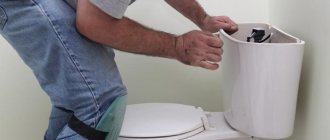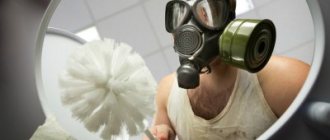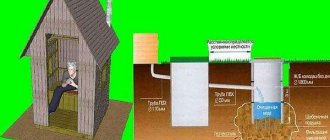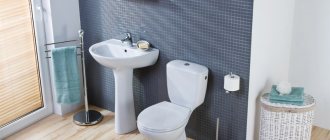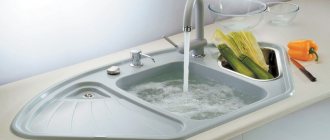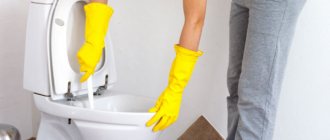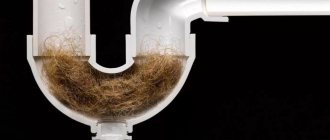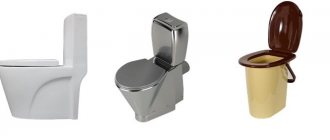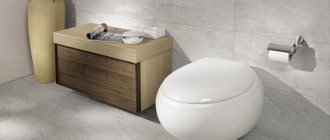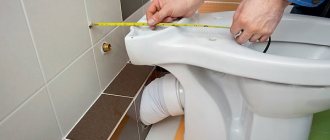Everyone at least once in their life has been faced with solving the problem of how to unclog a toilet.
Before you take active steps to deal with a disaster, it is important to assess the situation.
If contaminated water overflows and threatens to flood your home, call emergency services and the property management company immediately.
Even in the middle of the night, on a weekend, and you are not a permanent resident, all this no longer matters.
The emergency situation must be resolved by emergency services.
It is also necessary to shut off the sewer riser and notify other residents.
All this should be done by utility services while you perform emergency actions while waiting for the emergency crew.
But if the situation is unpleasant, but not critical, the toilet is clogged, water accumulates and passes very slowly, when the water is flushed, the drains rise in the bathroom drain hole, an unpleasant smell appears, you can start looking for the location of the blockage and try to find out how to remove the blockage in the toilet yourself.
It is necessary to eliminate the cause of clogged pipes, since improper operation of the sewerage system threatens the sanitary condition of the premises.
What can cause a clogged pipe?
Thick paper, newspapers, unshredded food waste, rags, sponges, congealed fat, any objects that accidentally fell into the drain, clumps of hair, plastic bags, used hygiene products.
Recently, clumping chemical cat litters have been added to the usual causes of pollution..
Such products literally cement the sewer, creating complete obstruction. In this case, only professionals can clean the pipes using special means.
To avoid sewer obstruction, it is highly advisable to place a convenient bucket with a lid for paper waste in the toilet. If all neighbors in the riser do the same, the likelihood of traffic jams in the sewer will be minimized.
Causes of a clogged toilet
To prevent such problems from occurring, it is important to understand what causes them.
In city apartments, traffic jams are formed by:
- a rag or sponge that fell into the toilet when pouring water from a bucket;
- large remnants of food unsuitable for canned food. Tea leaves and coffee grounds pose a serious danger, especially if deposits have already begun to form in the pipe;
- remnants of building mixtures: plaster, putty, tile adhesive. Having a much higher density compared to water, they settle in the pipe, harden and quickly render the sewer unusable;
- toilet paper. If the pipes are new, you can throw toilet paper down the toilet - it disintegrates in water. But you shouldn’t throw paper into an old sewer, which is probably already partially overgrown;
- lime and other mineral deposits. They are formed by salts contained in water.
In private houses, errors during sewer installation are added to the reasons mentioned:
- using pipes of smaller diameter than required. The risers and the section of the lounger after the toilet should be laid with a pipe with a diameter of at least 100 mm;
- laying horizontal pipes with insufficient or, on the contrary, excessive slope. In the first case, the wastewater moves with weak pressure and partially settles in the pipe; in the second, the water runs out too quickly and does not have time to wash away the heavy insoluble fractions, so they also remain in the pipe. The optimal slope for sewer pipes with a diameter of 100 mm is 0.02 (2 cm per meter), the minimum is 0.012 (1.2 cm per meter);
- installing the toilet too far from the riser. This distance is regulated by standards and according to them cannot exceed 1 m;
- lack of a vent pipe. Without communication between the sewer and the atmosphere, the drains slow down either due to the rarefaction of the environment behind them, or because they are supported by gases formed in the sewer and septic tank;
- pipe freezing. This happens if the outer part of the sewer system connecting the house with the septic tank is not deep enough. When frozen, it cracks and becomes permeable to the ground. The latter gradually forms a plug.
For preventive purposes, it is recommended to periodically treat the sewage system with chemicals.
What cleaning products are there?
Remedies and methods for toilet blockages can be divided into the following groups:
- 1. Chemicals and rinsing.
- 2. Mechanical means without pipe examination
- 3. Deep mechanical means (plumbing cables)
- 4. Technical. Dismantling of corrugations, a section of pipe, complete or partial replacement of the pipeline. In such cases, it is better to call emergency services.
The common goal of all methods is to clean the clogged section of the pipe and remove contamination.
Instructions for using a plunger to clean a toilet
There are no fundamental differences in the case of cleaning the toilet. The essence of the action is the same - the destructive effect of water pressure on the plug. To clean a toilet with a plunger, you will need to do the following:
- If the toilet bowl is filled with sewage, then scoop it out until the remaining liquid barely covers the plunger nozzle. If the bowl is completely empty, then on the contrary, you will need to add water to the same level.
- Then the plunger is applied with a suction cup to the inlet hole so that the edges of the suction cup rest as tightly as possible on the surface of the bowl.
- Now you need to move the plunger handle vertically about 10 - 15 times, but at the same time you need to make sure that the suction cup does not lag behind the surface of the toilet bowl.
- Having finished “pumping”, you should pull out the handle with a sharp movement. If everything was done correctly, you will hear a characteristic gurgling sound. In this case, pieces of cork should float to the surface. It is also possible that the blockage, together with the liquid, will rush down the drain with a characteristic sound.
- The procedure must be repeated until the toilet is clean.
- Once the clog has been cleared, you will need to flush the toilet again with water. As a preventive measure, you can add or fill in a pipe cleaner.
In a word, there is nothing complicated in this procedure. The degree of pressure directly depends on how intensively a person works with a plunger. But you also can’t overdo it in this matter. Millet because there is a risk that the remaining sewage will splash out over the edge of the toilet. It's not very pleasant or hygienic.
A plunger is a rubber cup-shaped attachment on a handle. It helps remove blockages that formed at the very beginning of the drain, so for simple blockages the plunger is very effective.
When cleaning a sink or toilet, it is necessary to wear special rubber or latex gloves - strong enough and thick enough. After cleaning, hands should be washed with soap. If the plug does not push through even after repeated attempts and intensive use of the device, this indicates that the blockage is located too far away, so the plunger will most likely be powerless here. It will be necessary to resort to other, more radical cleaning methods.
Chemical methods for cleaning pipes
Hot water
If you are confident in the quality of your plumbing, try unclogging your toilet by pouring a bucket of hot water into the toilet. Be careful, the water should be hot, but not boiling water . You need to fill the toilet to 80% and wait a couple of minutes, then try to break through the blockage with a plunger or simply flush the water.
By the way, this method works great if you clog the toilet with cat litter.
A simple way - a bucket of hot water with soda
A bucket of water will require about half a pack of soda.
This is a rather aggressive composition, but it will not be able to cause damage to pipes.
Baking soda effectively dissolves various organic contaminants and fats.
By the way, soda washes away burnt fat no less effectively than vaunted branded gels.
Another thing is that soda can simply clean off a Teflon surface due to its slight abrasive effect.
If the cork is soluble, then a hot soda solution will remove it.
Mole and its modifications
Acid-based products do not dissolve blockages, but they can seriously damage the pipes.
“Mole” is practically not suitable for cleaning the toilet due to the presence of a water lock.
“Mole” will get into the pipe, that is, into the workplace only in a very diluted form , which is absolutely unable to dissolve the blockage, but will completely damage the pipe.
Why are acid products not effective? The answer to this question lies in the chemistry course of the 8th-9th grade of high school and in the selective action of various acids. Acids that dissolve organic matter do not dissolve polyethylene, and it is plastic bags that cause half of the blockages.
Acids that dissolve polyethylene do not dissolve organic matter, but easily dissolve plastic sections of pipes and some metal structures.
The use of "Mole", effective in past decades, before the significant proliferation of plastic packaging, was very effective.
Currently, “Mole can be successfully used to dissolve organic blockages in the sewers of private houses.
Fairy tricks
It’s better to really pour half the bottle of “fairy” down the toilet. If the blockage is fatty, “fairy” will dissolve it without difficulty. But grease clogs, which are common in kitchens, are quite rare in fecal drains.
It is highly undesirable to flush shampoos and regular foaming detergents down the drain.
Folk remedies “Pepsi and cola”
Effectively removes yellow plaque and stains from plumbing fixtures. This is true. This is where the benefits of these drinks end.
Of the presented remedies, the most effective is a solution of baking soda in hot water..
We will not consider options with a bleach solution and pouring bottles of “whiteness” into the sewer.
Chlorine solutions are effective in preventing blockages when used regularly.
Several decades ago, disinfection of sanitary facilities with chlorine was a mandatory procedure in all public places.
In clinics, hospitals, first aid stations, government agencies. This procedure was abandoned due to the harmful effects of toxic chlorine fumes on the body. Modern disinfectants have a viscous structure and are characterized by a longer service life compared to liquid solutions and fewer harmful fumes.
Using disinfectants in the toilet flush cistern or bowl reduces the risk of clogs.
Read about installing a toilet on tiles in this article. And here is everything about the air valve for sewerage, types of valves for a private home and installation methods.
Advantages and disadvantages of using a plunger
You can consider the obvious advantages that a plunger provides in comparison with many other methods of clearing clogs:
- Its exceptional low cost;
- Extreme simplicity of design - thanks to which the plunger can fail after a very long time, even under intensive use;
- Easy to use;
- Effective for most types of blockages;
- In this case, there is practically no risk of damaging the toilet bowl or sink, as well as the surface of the pipe.
However, the plunger also has some disadvantages:
- Sometimes it is necessary to make a noticeable effort in order to clear too “stubborn” blockages;
- There is a possibility of spilling the contents of the toilet or sink if used too intensively;
- Although it works with most blockages, it does not work with all;
- Most effective for blockages located near the drain hole. The farther the blockage is located from it, the lower the efficiency.
A plunger is a suction cup attached to a wooden or plastic handle. It removes blockages by hydraulic shock against the blockage, pushing it through and destroying it.
Mechanical cleaning methods
Mechanical methods for cleaning pipes are generally more effective than chemical methods. There are household methods for clearing blockages, such as a plunger, and more technologically advanced ones for clearing blockages deep inside pipes, using plumbing cables.
Using a plunger
A plunger is an essential tool for effectively clearing small clogs.
The plunger creates hydraulic tension in the pipe, which destroys and pushes most of the contaminants forward.
How to use a plunger?
Take the plunger by the handle, place the suction cup over the drain and perform 5-10 sharp and strong pushing movements. Unstick the plunger and repeat the procedure if necessary.
Usually, several approaches and about 10 minutes are enough to remove the contamination.
After eliminating the contamination, for preventive purposes it is good to pour one or two buckets of warm water with soda into the toilet. The plunger must be kept clean and placed in a disinfectant liquid after use or rinsed thoroughly.
Plastic bottle
In case of emergency, a plastic bottle can replace a plunger.
How to use a pipe cleaner bottle?
The bottom is cut off from a plastic bottle, the cap is screwed tightly, and with the resulting device you can try to create a hydraulic wave, like a plunger.
After use, the contaminated bottle should be immediately disposed of in the trash.
Using a plumbing cable
The plumbing cable for drain cleaning comes in several modifications.
From household devices, no more than 5 meters long, to professional devices, which can easily break through a blockage in a toilet or pipeline.
An ordinary plumbing cable is an elastic, springy metal cable with a handle.
The cable is carefully inserted into the plumbing fixture and rotates, pushing through and destroying the cause of blockages. A metal brush is often made at the end of the cable, with which you can remove the object that caused the obstruction.
Scheme for cleaning a toilet with a plumbing cable
If the cause of the clogged pipe cannot be eliminated, contact the plumbers who service your home. Eliminating the cause of a pipe obstruction can take a long time and require special knowledge and skills.
In order not to take on unnecessary responsibility for flooding your neighbors with fecal matter as a result of unprofessional actions, it is better to seek help from specialists.
Independent removal of blockages
Method 1. Mechanical
It is used in cases where a rag or other similar object has gotten into the toilet flush siphon, and you definitely understand about it.
For the most part, a plumbing cable with a set of different attachments is used for cleaning. But it is unlikely that it will be at your disposal at the right time; therefore, in emergency cases, it is possible to remove the traffic jam simply by hand.
This is done as follows:
- It is necessary to scoop out all the water that is there from the toilet bowl.
- Put a rubber glove on your hand and protect your nose with a gauze bandage.
Advice! To get rid of an unpleasant smell in the toilet, you can light a huge piece of newspaper and let it burn. The flame will burn the hydrogen sulfide in the air, which is the cause of the unpleasant odor.
- Then you need to put your hand into the toilet and remove the object that caused the blockage.
- If you cannot do this with your fingers, you can bend a hook from a piece of steel wire, which will help hook the ill-fated rag.
Method 2. Using a plunger
This device can only be used to remove small blockages, while the toilet’s permeability is preserved, in other words, the poured water flows off, albeit slowly. Almost everyone has a plunger in their household, but for its effective use it is necessary that the diameter of the toilet drain hole be smaller than the size of the rubber suction cup.
Using a plunger, it is possible to remove blockages not only in the toilet, but also in the sink.
The principle of operation is simple. By working with the rubber part of this device, you create excess air pressure in the pipes, which pushes the clog further into the sewer. In most cases, pipes increase in size as they go deeper into the sewer system, so the plug will certainly dissolve and the passage of the toilet bowl will be restored.
In order to achieve a great result, you need to seal the drain and overflow holes in other plumbing fixtures connected to the sewer system with sealed plugs.
After this, the work is carried out in the following sequence:
- It is necessary to place the rubber suction cup of the plunger exactly above the drain hole of the toilet and press it firmly to the surface, achieving a strong seal.
- After this, make a couple of progressive movements up and down, after which you sharply tear the plunger away from the drain.
- If waste comes out, it must be removed, after which the procedure must be repeated until the toilet is fully operational.
Advice! If during the diagnostics you have determined that the water does not drain well in the kitchen, it is also necessary to clean it with a plunger.
Method 3. Chemical
How can you break through a toilet without a plunger? In this case, chemicals will help, which will destroy the blockage and restore the functionality of the toilet.
Note! Chemical methods will only help if the stopper in the siphon is made up of organic components. Any foreign object must be removed only by hand; no “chemistry” will help.
If you haven’t stocked up on special household products in advance, and you have a long distance to go to the nearest store, banal soda and vinegar, which are available in every housewife’s kitchen, will help remove the blockage.
The cleaning process looks like this:
- It is necessary to remove all the water from the toilet, leaving only a small amount at the very bottom.
- After this, soda is poured into the hole (up to half a standard pack). For greater results, it is necessary to ensure that the powder penetrates as deeply as possible inside the toilet.
- Then a glass of table vinegar is poured in the same direction.
- After this you need to wait min. twenty until the chemical reaction between the two substances ends.
- The process is completed with boiling water (five to six liters), which is poured into the toilet.
Note! If the connecting cuff between the toilet and the sewer pipe is made of corrugated plastic, it is better not to use boiling water, since the narrow polymer is not recommended for this and may collapse. Just use warm water at moderate temperature.
Greater results can be achieved if you use special products that are sold in stores. “Mole” is widely known and has proven itself, but any other can be used. Efficiency is virtually uniform.
Clearing a clog using a “doll”
The so-called “doll” is a homemade mechanism for effectively clearing blockages. It is made from fabric, sand for weight and rope.
The fabric is used as a bag to fill the weight. Tie the rope tightly to the bag so that it does not come off. How to clean a toilet using a “doll”:
- Place the mechanism in the drain hole and drain the water.
- The water flow should carry the “doll” along with it, while holding the rope very tightly.
- Gently lift the weight using the rope.
- Due to its heaviness, such a device should help you clear the blockage.
Note!
How to update the tiles in the bathroom without changing them or removing them: step-by-step instructions, stickers, painting, decor (140 photos)
Do-it-yourself Venetian plaster walls: types, application instructions, photos of beautiful wall decoration, colors
Decorating the inside of a balcony: types of materials, design photos, review of the best ideas for interior decoration
Determining the specific point of blockage
Once you have identified the problem, you need to understand where exactly the clog is accumulating. If it has accumulated in the toilet, then the water in the sink should drain without problems. Check this by opening the faucet in the bathroom.
If you find water standing in the sink, then the problem is much deeper. Most likely, your drain is clogged. In this case, immediately call utility services. You won't be able to solve this problem on your own.
